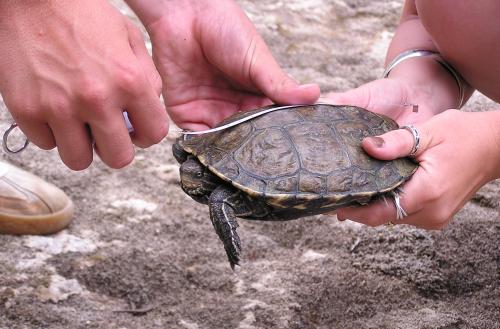BASIC ORGANISATION 01/68 OF THE CZECH UNION FOR NATURE CONSERVATION
PROTECTION
H E R P E T O F A U N A E

Jankovcova 47, 170 00 Praha 7 - Holešovice, Czech Republic
Project Mauremys
Thermophile species of Balkan fauna spread the furthest to the north on the Adriatic coast and follow the narrow stripe of warmer climate, separated from the colder inland parts by the mountain ranges.
The south-Balkan carnivorous Balkan Terrapin (Mauremys rivulata, earlier Mauremys caspica rivulata, even earlier Clemmys caspica) is common in the waters of Greece, rare in Albania and Macedonia and in a few isolated cases it was discovered in Montenegro.
We obtained the first information about its occurrence in Croatia in 1978 from Dubrovnik ornithologist Ivan Tutman, who showed us two small ponds (about 20 square metres) near his house, in the middle of waterless karst terrain.

Later, in 1980, we discovered another insulated place of occurrence of this species even further to the north, on the Pelješac peninsula in a brook and irrigation channels of orchards, where these terrapins lived together with the European Pond Terrapin (Emys orbicularis). These micro-localities used to be very densely populated by the terrapins, until their water environment was negatively affected.

The brook on the Pelješac was destroyed, its spring being embedded in concrete and its water being used for the municipal water mains. Agrochemicals started to be used more frequently in the orchards, soaking gradually into the irrigation channels and affecting the terrapins’ food supplies. In 1994 we found out that “our” first well known pair of small ponds near Dubrovnik became a disposal of mine thrower shells during the civil war incidents.

So we clasified the situation as critical endangering of one of the most valuable items of the very rich Croatian reptile fauna and we alerted the Nature Conservation Institute as well as the Natural History Museum to the danger of extinction, which could happen in a very short time if nothing is done for its preservation. The project supposed i. a. attempts to transfer of a small number of specimens into selected ponds, where it hadn’t occurred, but where there was a bigger chance of remaining – in fact creating genetic fund reservoirs for the case that the destruction of the minute original habitats.
According to the public authorities’ executive decision these steps were supposed to be executed in cooperation of our organisation and the specialists from the Natural History Museum in Zagreb. Unfortunately, they didn’t manage to obtain adequate financial resources and as real professionals they put us to deal with this matter at our own charge. But at least we got an official authorization, so that our activity couldn’t evoke doubts of local executive authorities.

We managed to discover several ponds with qualities corresponding to the needs of the species and we executed experimental introductions. I two cases we registered retaining of the transfer (which is nod easy – the terrapins are very easily frightened) and in one case even reports of observation of young. At the same time we tried to involve local residents and school children. We were successful especially among the latter and several ecologically oriented groups of students became interested in the problem. Even more remarkable achievement for enabling further effective conservation measures was involving a newly founded ecologist group Hyla, which consists mainly of students of a natural history faculty. Its members understand the meaning of the action and started to promote especially the conservation management of the original localities much easier than we could.

Nowadays observation of the experimental transfers is carried out, as well as documentation of other discovered localities in the very southern tail of Croatian territory, which are connected to those in the Boka Kotrska bay.
